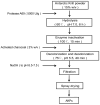Potential of Marine Bacterial Metalloprotease A69 in the Preparation of Antarctic Krill Peptides with Multi-Bioactivities
- PMID: 40559635
- PMCID: PMC12194120
- DOI: 10.3390/md23060226
Potential of Marine Bacterial Metalloprotease A69 in the Preparation of Antarctic Krill Peptides with Multi-Bioactivities
Abstract
Antarctic krill (Euphausia superba) is a nutrient-rich marine resource. Although several terrestrial proteases have been used to prepare Antarctic krill peptides (AKPs), there has been no report on the preparation of AKPs using a marine protease. Here, marine bacterial protease A69 was used to prepare AKPs with multi-bioactivities. Through optimizing hydrolysis parameters, we established a process for AKPs preparation by hydrolyzing Antarctic krill powder with A69. In the prepared AKPs, peptides less than 3000 Da and 1000 Da accounted for 99.23% and 88.37%, respectively. The scavenging ratios of the AKPs to ABTS+, DPPH· and ·OH reached 93.23 ± 0.09%, 99.90 ± 0.15%, and 93.90 ± 0.47%, respectively. The AKPs also had high angiotensin-converting enzyme (ACE)-inhibitory activity, with an IC50 of 0.22 ± 0.04 mg/mL. At 40 mg/mL, the AKPs inhibited α-glucosidase and dipeptidyl peptidase IV (DPP-IV) activities by 7.18% and 13.62%, respectively, and displayed antibacterial activity to Escherichia coli. Moreover, 14 antioxidant peptides, 24 ACE-inhibitory peptides, 2 α-glucosidase-inhibitory peptides, and 10 DPP-Ⅳ-inhibitory peptides were identified from the AKPs. These results demonstrate that the prepared AKPs contain diverse bioactive peptides and have multi-bioactivities. This study indicates that marine bacterial protease A69 has promising application potential in preparing AKPs with multi-bioactivities.
Keywords: Antarctic krill peptides; angiotensin-converting enzyme (ACE)-inhibitory activity; antibacterial activity; antioxidant activity; dipeptidyl peptidase IV (DPP-IV)-inhibitory activity; marine bacterial protease A69; α-glucosidase-inhibitory activity.
Conflict of interest statement
The authors declare no conflicts of interest.
Figures








Similar articles
-
Potential of Marine Bacterial Metalloprotease A69 in the Preparation of Peanut Peptides with Angiotensin-Converting Enzyme (ACE)-Inhibitory and Antioxidant Properties.Mar Drugs. 2024 Jun 29;22(7):305. doi: 10.3390/md22070305. Mar Drugs. 2024. PMID: 39057414 Free PMC article.
-
Two Novel Bioactive Peptides from Antarctic Krill with Dual Angiotensin Converting Enzyme and Dipeptidyl Peptidase IV Inhibitory Activities.J Food Sci. 2017 Jul;82(7):1742-1749. doi: 10.1111/1750-3841.13735. Epub 2017 May 27. J Food Sci. 2017. PMID: 28556182
-
Systemic pharmacological treatments for chronic plaque psoriasis: a network meta-analysis.Cochrane Database Syst Rev. 2021 Apr 19;4(4):CD011535. doi: 10.1002/14651858.CD011535.pub4. Cochrane Database Syst Rev. 2021. Update in: Cochrane Database Syst Rev. 2022 May 23;5:CD011535. doi: 10.1002/14651858.CD011535.pub5. PMID: 33871055 Free PMC article. Updated.
-
Dipeptidyl-peptidase (DPP)-4 inhibitors and glucagon-like peptide (GLP)-1 analogues for prevention or delay of type 2 diabetes mellitus and its associated complications in people at increased risk for the development of type 2 diabetes mellitus.Cochrane Database Syst Rev. 2017 May 10;5(5):CD012204. doi: 10.1002/14651858.CD012204.pub2. Cochrane Database Syst Rev. 2017. PMID: 28489279 Free PMC article.
-
Angiotensin-converting enzyme inhibitors and angiotensin receptor blockers for adults with early (stage 1 to 3) non-diabetic chronic kidney disease.Cochrane Database Syst Rev. 2011 Oct 5;(10):CD007751. doi: 10.1002/14651858.CD007751.pub2. Cochrane Database Syst Rev. 2011. Update in: Cochrane Database Syst Rev. 2023 Jul 19;7:CD007751. doi: 10.1002/14651858.CD007751.pub3. PMID: 21975774 Updated.
References
MeSH terms
Substances
Grants and funding
LinkOut - more resources
Full Text Sources
Miscellaneous

